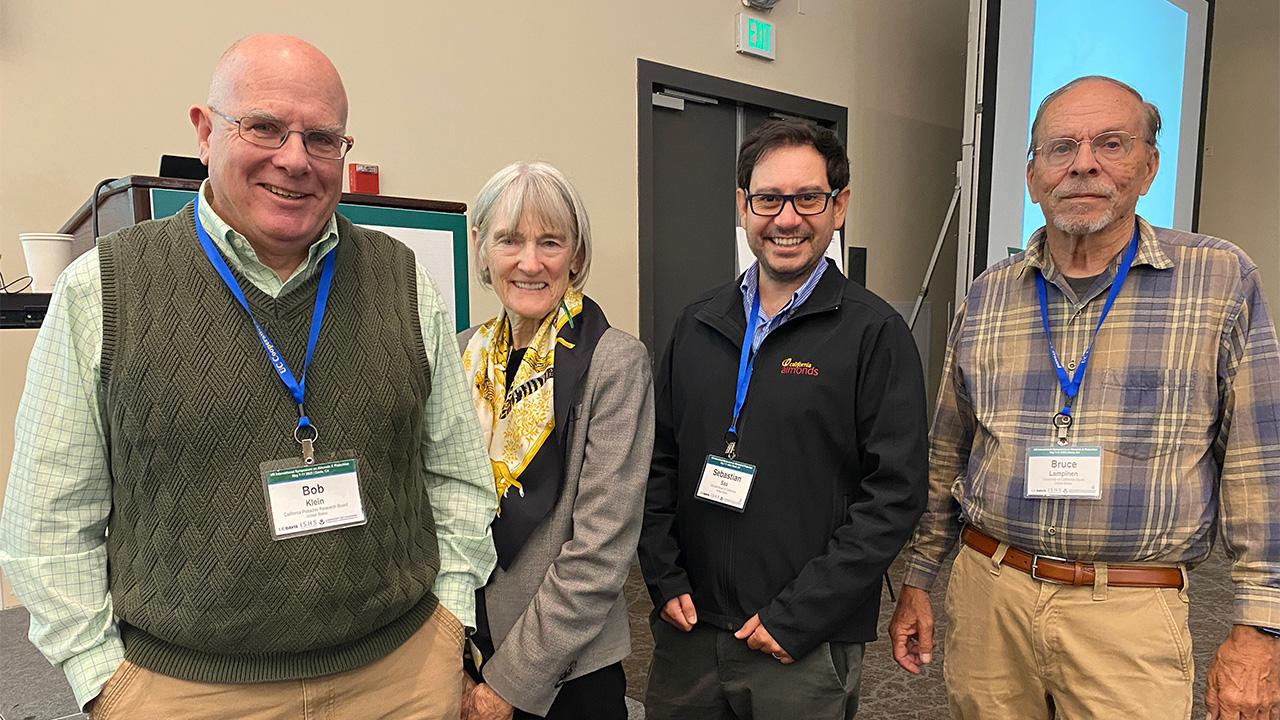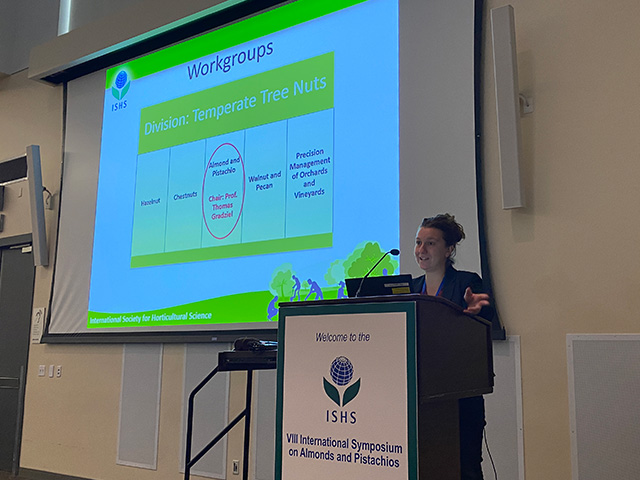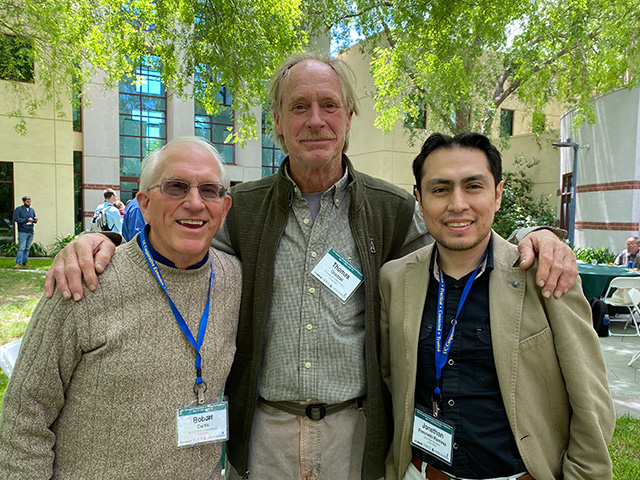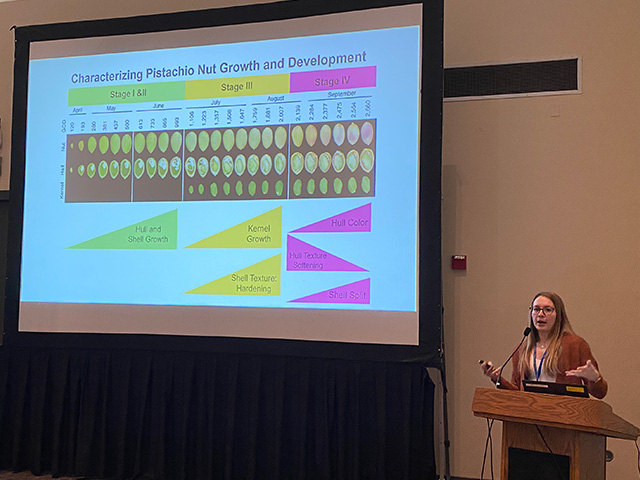
Almonds and pistachios face international challenges
Researchers outline possible solutions during ISHS symposium

Tree nut experts from around the world are gathering at the UC Davis Convention Center this week to discuss the challenges faced by the people growing and processing almonds and pistachios. Researchers are outlining possible solutions and exchanging ideas for how to combat problems of water scarcity, increasingly saline water and soils, rising wintertime temperatures and new pests that come with the changing conditions.
The University of California Agricultural and Natural Resources division and the UC Davis Department of Plant Sciences are hosting the 8th International Symposium on Almonds and Pistachios of the International Society for Horticultural Science. It’s the first time the organization has met in person since the start of the COVID-19 pandemic more than three years ago.
Symposium conveners and organizers are Louise Ferguson, Bruce Lampinen, both professors of Cooperative Extension, and Thomas Gradziel, a professor, all in the Department of Plant Sciences
Tree nut industry is growing worldwide
Some highlights that emerged from the meeting’s first morning include:
- Worldwide, tree nut production has grown dramatically in the past decade, led by almonds, walnuts, cashews and pistachios. But challenges include maintaining demand, increasing value added, reducing input costs, regulations and climate change, said Sebastian Saa, associate director of agricultural research at the Almond Board of California.

Thomas Gradziel, center, a professor in the UC Davis Department of Plant Sciences, with Bob Curtis, right, retired from the Almond Board of California, and Jonathan Fresnedo Ramirez, of Ohio State University, during the VIII International Symposium on Almonds and Pistachios, of the International Society for Horticultural Science. Gradziel is one of the three co-conveners in the department of the gathering. (Trina Kleist/UC Davis) - In California alone, growers have planted 550,000 acres of pistachios as of this year, with 450,000 acres expected to bear nearly 1.2 billion pounds of nuts, said Bob Klein, manager of the Administrative Committee for Pistachios for the California Pistachio Research Board.
- For almonds, the high costs of land, water and labor threaten the industry. Meanwhile, the shift to self-pollinating trees has brought some advantages but poses new difficulties. Worldwide, the dominance of just three cultivars, and the genetic inbreeding that results, poses challenges to finding new cultivars that will thrive in new conditions, Gradziel said. Nevertheless, an experimental orchard near campus is testing many possibilities, he added.
- In pistachios, the Golden Hills female cultivar, released in 2006, and the Lost Hills female cultivar, released in 2007, both by the Parfitt-Kallsen-Maranto breeding program at UC Davis, have proven to have many benefits over the Kerman variety that has dominated cultivation for many decades, said Dan Parfitt, a pomologist emeritus in the department.
New research presented

A few highlights presented Monday morning:

- Researchers in the Monroe Lab are developing a pan-genome for pistachios, providing reference-quality genomes for multiple cultivars. Work includes sequencing hundreds of genotypes, said Assistant Professor Grey Monroe. He encouraged researchers who want to contribute to the catalogue to contact him at gmonroe@ucdavis.edu
- Chaehee Lee, a postdoctoral researcher in the Monroe Lab, is exploring the Kerman genome to associate traits of interest with specific locations on the genome.
- Patrick J. Brown, an associate professor and nut crop breeder, is researching the genetic basis of how pistachio trees tolerate high levels of salts in the water they take up. “The plant is doing something to exclude salt as it pulls up water,” he said, possibly sequestering salt in leaves. He called on scientists around the world to work together to find answers.
- While the new cultivar Golden Hills was advantageous compared to Kerman, its productivity in recent years is proving to be more variable than Kerman when warmer winters fail to provide sufficient chill, doctoral candidate Jaclyn Adaskaveg found. She’s working on post-harvest issues in the lab of Barbara Blanco-Ulate.
- Franklin Lewis, an assistant specialist in Brown’s lab, had a warning for fellow scientists seeking the genetic basis for good size, salt tolerance and other traits in pistachio trees: Genotypes that create good-looking trees in the greenhouse typically do not perform well in the field, but trees with the “bad genes” typically do, he found.
Conference details
Many more researchers are presenting their work during the symposium. Find more, listed in the agenda, here.
Get the symposium book of abstracts here.
Learn more about the International Society for Horticultural Science here.
Media Resources
- Trina Kleist, UC Davis Department of Plant Sciences, tkleist@ucdavis.edu, (530) 601-6846
